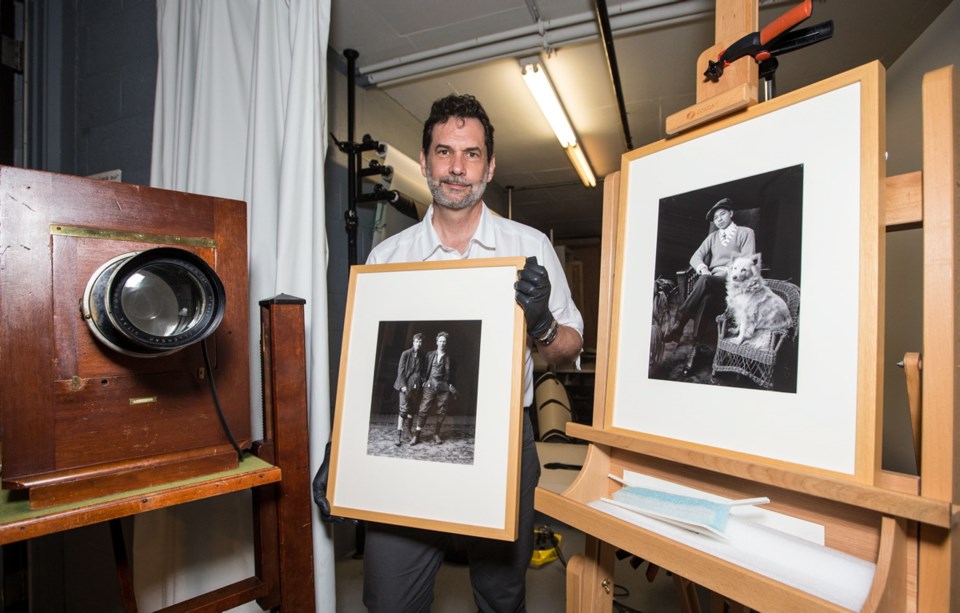What: Mirror with Memory
Where: Art Gallery of Greater Victoria
When: Opens with free open house on Saturday from 10 a.m. to 5 p.m. Exhibit continues to Sept. 4
Gallery admission: $2.50, $11, $13 (free for children under five)
The two young men from the early 1900s didn’t bother to dress up for the occasion. In a photograph, their hair is uncombed, cigarettes dangle from their mouths. One has an unbuttoned shirt, the other sports a half-rolled-up trouser leg.
It appears the pair have committed another sartorial faux pas as well.
“They look like they’ve just come in from the pub. They haven’t even bothered to do up their pants,” said Stephen Topfer, the curator of Mirror with Memory, a new photo exhibit at the Art Gallery of Greater Victoria.
Acquiring such a memento was a luxury. The images in this exhibition, spanning 1912 to 1942, were painstakingly captured with cameras using silvered glass-plate negatives. Retouching was done by hand.
“For [the men in the photo] to get their pictures taken, it would have been the equivalent of about a day’s wages,” Topfer said.
Mirror with Memory — 27 prints and 60 more projected images — features photos from a single Japanese-Canadian studio in Cumberland in the Comox Valley. The studio was founded by photographer Senjiro Hayasi, an immigrant, and later taken over by apprentices.
The exhibit portrays a slice of life from early 20th-century Cumberland, the Vancouver Island mining town built in 1888 by coal baron Robert Dunsmuir. There is a wide variety of images — families, friends, baseball players, labourers toiling in coal mines.
It includes the only known photos of the Cumberland funeral procession of Ginger Goodwin, the workers’ rights activist who was shot to death in 1918 by an ex-policeman.
As the coal-mining boom reached its height, Cumberland was home to one of the largest so-called Chinatowns on the West Coast. Not surprisingly, many of the photographs in Mirror with Memory are of Japanese immigrants.
There is, for example, a group of Asian men in miners’ hats proudly holding lunch pails. It was common for immigrants to have photos taken to show off their prosperity to families or prospective brides back home. Another photo is of a well-dressed young man in a college-style sweater, tie and high collar, his dog perched on a wicker chair beside him.
Some images show immigrants assimilating the culture of their new homeland. There is a photograph of two Japanese men in baseball uniforms. The sport was so popular among new immigrants that an Asian baseball league flourished up and down North America’s West Coast, Topfer said.
He noted that Mirror with Memory carries an unhappy subtext. Seventy-five years ago, prime minister William Lyon Mackenzie King imposed the War Measures Act, which led to the internment of 22,000 Japanese Canadians. Like many Canadian communities, Cumberland’s Japanese population was affected.
The final commission of Hayasi’s Cumberland studio (by this time taken over by apprentice Tokitaro Matsubuchi) was to take photographs for the registration cards the Canadian government insisted all Japanese immigrants carry. In 1942, 585 Japanese-Canadians living in Cumberland were permanently removed from their homes and stripped of their possessions.
“What wasn’t nailed down was basically taken,” Topfer said. “The initial rationale [from the government] was: ‘Oh, we’ll look after it for your own benefit in case we have to move you off the West Coast [to internment camps]. That quickly turned into: ‘We’re going to have to sell off this stuff.’ ”
Between 1943 and 1946, the federal government sold all Japanese-Canadian owned property, including homes and businesses.
Hayasi had apprenticed to a Vancouver photographer before moving to Cumberland and setting up his studio.
Afterward, he farmed for a time in Abbotsford. Topfer believes his family eventually moved to Ontario.
The photographs in Mirror with Memory come from the Cumberland Museum and Archives, a partner in the exhibition. There is also historical material from the Royal British Columbia Museum and Burnaby’s Nikkei National Museum and Cultural Centre.
Topfer is the Art Gallery of Greater Victoria’s manager of collections and exhibits. He came across the Cumberland photos while researching for his history degree at the University of Victoria.
Using vintage cameras, it might have taken 20 minutes to set up and take just one of the photographs in Mirror with Memory. It was a much different world than our snap-happy age.
“That’s the other thing that’s hard to convey to people now, when images are ubiquitous everywhere,” Topfer said. “But these photographs are still better resolution than what you can take with a digital camera.”



